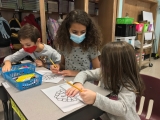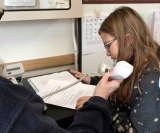-
Category 1
Selected in 2021
-
Grades: k - 5
School Setting: urban
Town Population: 63,042
Student Enrollment: 223
Student Demographics:
Black/African American: 2.4%
Teacher/Student Ratio: 1:10.3
White/Caucasian: 78.5%
Hispanic: 12.4%
Hawaiian/Pacific Islander: 0%
Asian: 3.3%
Native American: 0%
Other: 3.3%
% Reduced Lunch: 49%
% ELL Learners: 18%
Founded: 1951 -
PRINCIPAL:
Christine Morgan -
CONTACT:
25 Alden Street
Plymouth, MA 02360
508-830-4335
cmorgan@plymouth.k12.ma.us
Cold Spring Elementary School
Plymouth, MA
Cold Spring’s success is based on believing in our mission to create an inclusive atmosphere of enrichment and belonging that promotes student academic success."
- 1. Tell us about your school’s success.
- Cold Spring’s success is based on believing in our mission to create an inclusive atmosphere of enrichment and belonging that promotes student academic success. As a Title 1 and an EL designated school, all staff strive to empower students' social, emotional and academic growth by providing a learning environment that is positive, nurturing and respectful. Through partnerships with parents, Cold Spring School works to provide a collaborative environment that inspires and empowers student leadership, critical thinking and compassion for one another. Cold Spring has a population that includes students in Kindergarten through Grade Five. Cold Spring School strives to provide a well-rounded educational experience, building strong supportive family and community partnerships helping to mold future leaders of the community. When children walk through our doors they are greeted with love and respect. All students are taught to be active participants in their learning through goal setting.
- 2. Talk about the greatest contributing factor(s) that promoted positive change in your school.
- The Cold Spring staff are dedicated educators who work endlessly to provide positive educational and social/emotional experiences for all children. Our teaching staff expanded their instructional practice through professional development opportunities and created building wide goals. The professional development consisted of working on curriculum initiatives, reviewing student data and continuous progress monitoring. We looked at each student individually, so that we could design learning experiences unique to the students learning needs. Our professional development consisted of several formats. Grade level teachers had common planning and teachers collaboratively created learning experiences that differentiated the learning to meet the needs of the students in their classroom. Monthly grade level meetings focused on ELA and Math concepts and best practice. Professional Learning Communities continued the work of the grade level meetings that provided continuous collaboration. .
- 3. How has ESEA funding supported the school's success?
-
The ESEA Funds support Cold Spring’s programming in various ways. Cold Spring has three Title 1 teachers that collaborate with classroom teachers to support student learning, implement progress monitoring and RTI interventions in small group settings. As a whole school Title 1 school, all students have access to Title 1 services. ESEA funding allows for family engagement opportunities so that parents can engage and connect them to their child’s learning experience. Family after school events such as One School One Book, Reading Incentive Program, literacy night, family game night and Lending Library provide educational activities and opportunities for parents to support their child’s learning at home. Evening parent curriculum nights offer many programs for parents to learn about current curriculum initiatives. Students are provided before and after school instructional and fun activities to meet the various learning and social/emotional needs across all of the grade levels.
- 4. What professional development activities were used to improve teaching and learning?
- At Cold Spring we continued to work to provide best instructional practice through many building wide professional development and goal setting excercises. The Cold Spring teaching staff participated in multiple professional development opportunities that brought grade level teams together to work on curriculum initiatives and review student data in ELA and Math. Staff members met each month to plan specific subject matter, differentiated learning experiences and instructional practices that addressed the Massachusetts curriculum standards. The team approach to learning focused on instructional practice and unit development/ design to inform best practice decisions. As a whole building, the staff of Cold Spring created two building wide academic goals in which all instructional staff focused on to implement strategies for improvement. Within the classroom, students created individual goals and tracked their progress toward their goals in with personal binders or as a whole class.
- 5. Talk about the cultural shift leading up to your school's success.
-
Continuous collaboration is the key leading to Cold Spring's success. Our school has an atmosphere of enrichment and belonging that promotes student confidence and leadership. We strive to empower students' social, emotional and academic growth by providing a learning environment that is positive, nurturing and respectful. Through partnerships with parents Cold Spring School works to provide an environment that inspires and empowers student leadership, critical thinking and compassion for one another. Cold Spring is a Leader in Me School. We implement Dr. Stephen Covey’s philosophy of leadership through living the 7 habits of highly effective people. Students are encouraged to take responsibility for their learning through personal goal setting. All students and staff track progress towards individual and building wide goals. Our intent has been to increase the rigor of instructional practice and enhance all student problem solving and critical thinking experiences.
- 6. How has community involvement strengthened your success?
- Community involvement is key to the success of our school. Partnerships with family and local businesses that support our school are so important. Our families are encouraged to volunteer and take part in the learning activities within our school. Communication is a common feature with all teachers. At our school, we make sure that all communication is provided in the home language of our families so that all parents and students have access to the classroom, building, and district events. Each week newsletters go home to families from the classroom teachers and the Principal. The Pandemic changed our way of doing things but we found creative ways to continue to involve our families and to bring student performances and showcase student work through technological tools. Keeping the school and home connected and working as a team was vital during this time to support the children of Cold Spring.
Stats
-
Category 1
Selected in 2021
-
Grades: k - 5
School Setting: urban
Town Population: 63,042
Student Enrollment: 223
Student Demographics:
Black/African American: 2.4%
Teacher/Student Ratio: 1:10.3
White/Caucasian: 78.5%
Hispanic: 12.4%
Hawaiian/Pacific Islander: 0%
Asian: 3.3%
Native American: 0%
Other: 3.3%
% Reduced Lunch: 49%
% ELL Learners: 18%
Founded: 1951 -
PRINCIPAL:
Christine Morgan -
CONTACT:
25 Alden Street
Plymouth, MA 02360
508-830-4335
cmorgan@plymouth.k12.ma.us










